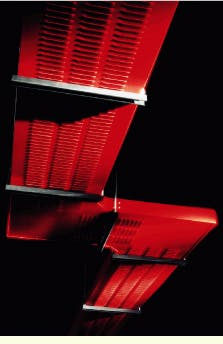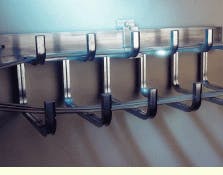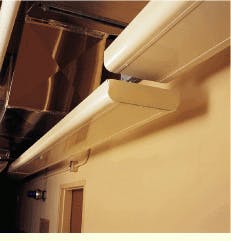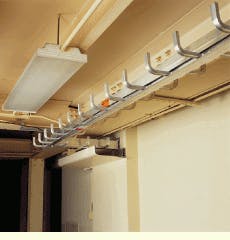Suspended or wall-mounted, cable-management systems offer flexibility in demanding applications.
Don Sementilli,
The Wiremold Co.
Major trends affecting cable-management systems include the explosive growth of information technology and the increased reliance of businesses and institutions on high-performance data-communications systems. What`s more, people are working in ways--and spaces--that were unimaginable just a few years ago. As a result, a building`s cable-distribution system must be easily upgradable, reconfigurable, and movable.
Another trend is the well-documented migration of electrical contractors into installing low-voltage systems alongside their former bread-and-butter electrical work. Not only are these contractors learning a new discipline, but they also are facing increased pressure brought on by compressed, fast-track construction schedules.
One of the most widely used cable-management infrastructures is overhead plenum-rated cable in cable trays. These trays often provide high capacity and convenient access to cabling networks that must be upgraded, reconfigured, or relocated. Installers now have a wider choice of overhead systems, many of which allow the laying in of new or removal of old cable without the time and expense of pulling.
Choice of systems
The variety and sophistication of overhead distribution systems offer greater choice in selecting the right cable tray for new construction and retrofits. These systems include wireway and cable tray, which are available in single-channel and divided configurations with a variety of sizes as well as cover and hanging options.
Solid-bottom cable trays offer an effective way to manage wiring while keeping it accessible, organized, and secure. These systems accommodate large numbers of branch lines and offer high load-bearing capacity. Technicians can install one or more dividers to separate power and data lines and organize cabling. For added cabling protection, solid-bottom cable trays can be specified with or without covers. Ventilated louvers also can be specified to facilitate cooling and prevent moisture buildup by natural convection, while keeping conductors enclosed and protected. Solid-bottom cable trays can be hung using either a central rod support, C-hanger, or two-hanger trapeze configuration; and they can be wall-mounted using brackets.
Center-spine cable trays consist of a central support member from which extends a series of rungs that support the cable. The tray hangs from central rods, rather than from lateral trapeze-like suspensions. This configuration allows cables to be laid in the tray and often eliminates the need for labor-intensive cable pulling. All center-spine cable trays are not the same. The best designs have screw-in rungs that can be removed and replaced. Rungs should also feature factory-installed end caps to prevent damage to cables and injury to installers.
Wall-mounted cable trays are a version of the center-spine tray but have rungs on only one side of the spine, allowing the tray to be mounted directly to a wall, rather than hung. Wall-mounted cable trays enable installers to use side-wall space and avoid the congestion of lighting, heating, ventilation, air-conditioning, fire alarm, and sprinkler systems, which are often found in the center of rooms and hallways.
Wireway is a totally enclosed system that does not provide for access to the wiring or cabling contained within. Hinged or screw-on covers provide complete protection, while allowing convenient access to add, remove, or reconfigure cabling. One way in which wireway differs from solid-bottom cable tray is that it requires that the cables be covered.
Ladder cable trays offer strength and high capacity and are thus well-suited to heavy-duty power-distribution applications. Ladder trays, however, do not offer the flexibility of solid-bottom or center-spine cable trays, since cables must be pulled rather than laid in place.
Many manufacturers offer cable trays in a range of standard and custom colors. While color is certainly an aesthetic consideration, it also has practical value in a large and complex facility, where colors can serve as guides to the wiring and cabling contained in the system. For example, a facility may run all of its copper cabling in a blue cable-tray system and its fiber-optic cabling in an orange one to provide instant identification.
Overhead cable-distribution systems are designed to accommodate all types of communications cabling. But, high-performance unshielded twisted-pair (utp) and fiber-optic cabling present some special considerations. Maintaining the precise bend-radius requirements of high-performance cabling is essential to ensure its integrity and overall performance. Dropout fittings used with cable-tray systems facilitate a smooth transition from the overhead tray down to the workstation without excessive bending or cable stress.
Cable trays that are designed for use with high-performance utp and fiber-optic cabling also incorporate rungs that offer a 1-inch cable-laying surface. This wide support surface helps prevent damage to the cable insulation, which often occurs when narrow rungs are used and the cable sags on both sides of the rung.
Labor-saving benefits
Of critical importance in today`s competitive marketplace is the ability to install a new or retrofit cabling system quickly and efficiently. Many overhead cable-management systems have been engineered to provide tangible benefits to contractors and system installers. For example, cable trays that are suspended from a central rod, rather than a trapeze, offer the inherent advantage of cutting in half the time required to install the hangers. In addition, the central-rod configuration allows cable to be laid into the tray instead of being pulled through. This not only speeds up the installation, but it also helps to protect sensitive cables from stress.
When working in previously occupied space where ceilings are already in place, installation contractors encounter an array of ducts, pipes, hangers, and other building system infrastructure. Adjustable center-spine cable tray can be easily offset to go around the obstacles. This flexibility is achieved through fieldinstalled T-fittings and horizontal and vertical pivots, which function as hinges and provide precisely controlled routing from straight runs to 90o turns. Thus, the cable tray can be adjusted both laterally and vertically to avoid obstructions. Screw-in rungs can be easily removed to facilitate installation in tight locations.
One recent project offered a floor-to-floor comparison between adjustable center-spine cable trays and conventional ladder trays. It took two workers four days to install approximately 600 feet of steel-ladder trays on one floor. On the remaining floors where center-spine tray was installed, the installation was faster, especially as the crew became familiar with the system. While actual installation times varied with the number and type of obstacles encountered, adjustable center-spine cable trays proved to be significantly faster to install than ladder trays. Another labor-saving advantage to center-spine cable trays is that they are lighter and easier to maneuver than ladder trays, so installers can get more work done.
Overhead cable-management systems provide the flexibility to accommodate day-to-day challenges such as relocating workstations and long-term issues such as new or expanded technologies over the life of the building. The increasing variety of cable-tray systems on the market today offers technicians a greater choice of solutions and the opportunity to improve productivity through more efficient installation.
Louvers in a solid-bottom cable tray facilitate air flow and prevent moisture buildup around cabling.
For added capacity, wall-mounted cable trays are available in single-, double-, and triple-tier configurations.
Blending the old with the new at the Smithsonian
The original section of the National Museum of Natural History in Washington, DC, a part of the Smithsonian Institution, is a venerable building. At the time of its construction in the early 1900s, architects were still debating whether to provide gas lamps or electric lights. "Fortunately they made the right choice and went with electricity. But of course they made no provisions for a structured-cabling system," says Bruce Daniels, operations manager of the museum`s automated data processing department.
While the public is familiar with the museum`s exhibition areas, the building also contains offices and work spaces for some 1000 employees, including scientists, exhibit designers, and librarians. "The newer wings do have structured-wiring systems, but the main building does not. We needed to bring it into the information age with a data-network system using a fiber-optic backbone and thousands of individual drops," says Daniels.
The problem was where to locate the cable system. Although parts of the building are equipped with infloor duct systems, the capacity was not sufficient to handle additional communications cabling. In addition, very few of the offices have easily accessible ceilings where cabling could be located. As a result, much of the wiring and cabling that had been added over the years had been run through wall- and ceiling-mounted conduit--an arrangement that detracted from the museum`s stately decor.
It was clear that a new cable-distribution system was needed--one that would be flexible, accessible, and unobtrusive. "We required adequate capacity and flexibility, and we wanted a more aesthetic solution than just adding more conduit," explains Daniels.
The solution was a wall-mounted cable-tray system from The Wiremold Co. The tray`s primary rail, or spine, attaches securely to the wall while removable 1-inch rungs curve upward, cradling the cables. This spine-and-rung design allows cables to be laid in from the side, rather than pulled, as is the case with some cable-tray systems. The wide rungs also provide a solid support surface for fiber-optic cabling, minimizing the potential for microbending of cables over time. Integral screw grooves in each rung accept rung-mounted accessories such as cable dropouts, which maintain the proper bend radius and reduce strain as the cable is run from the tray down to the point of use.
"Wall-mounted tray gives us good flexibility in our office and administrative areas, where we can accommodate the shifting of people from one location to another and provide new data services as they are needed," says Daniels.
The wall-mounted cable tray also met the museum`s aesthetic requirements. An optional curved metal cover that screws onto the outside of the cable-tray rungs was painted to match the plaster ceilings, creating an attractive cove effect. "Early in the installation--when the spine and rungs were still visible--we had some complaints from employees about the way it looked, but once the covers went on we had no complaints at all. The cable tray blends right in with the ceiling," notes Daniels. The completed cable-tray system even provided an aesthetic bonus by hiding some of the existing conduit.
Visitors to the National Museum of Natural History will not see the fiber-optic installation as they explore the exhibits, and the people behind the scenes barely notice it either, thanks to its new cable-management solution. But the magnificent museum, built during the dawn of the electric age, has been brought unobtrusively into the information age.
The cable trays installed at the Smithsonian Institution`s National Museum of Natural History have covers that help the system blend in with the surroundings.
With the covers removed, the wall-mounted cable-tray system is visible.
Don Sementilli is product business manager for overhead systems at The Wiremold Co. (Bristol, CT).




